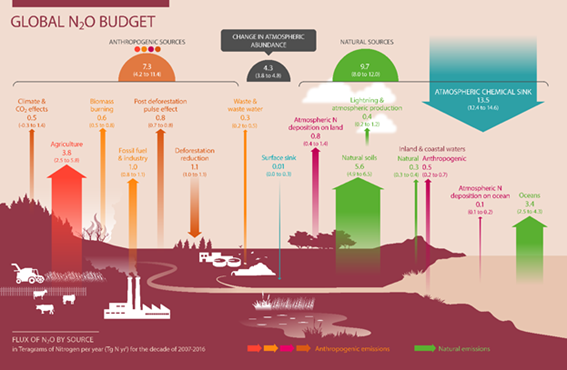Global Nitrous Oxide Budget 2020 and our food system – Public Forum (Oct 29th 2020)
On 7th October, a Nature scientific article by GCP researchers reports on a continued increasing global N2O emission over the past four decades. The increase is primarily driven by human-induced emissions which has risen by 30% over the period. Overall, agricultural activities dominated the growth in the emissions with the use of Nitrogen fertilizers in agriculture including livestock manure production.
GCP Tsukuba and NIES are also orgnanising a public forum on this topic under title (see poster):
Global Nitrous Oxide and our food system on 29th October 2020. 09:30〜11:30 (Japanese) 13:00 〜 15:30 (English) Registration is free - https://bit.ly/2EA3hod
Global nitrous oxide budget 2020 - A comprehensive quantification of global nitrous oxide sources and sinks. Nature. https://doi.org/10.1038/s41586-020-2780-0
Headline: Agricultural production contributed 82% to the global anthropogenic N2O emission in the recent decade, highlighting the urgency to mitigate the impacts of our food system on climate change.
Summary
Nitrous oxide (N2O) is one of the primary greenhouse gases that contribute toward global warming. Nitrous oxide is less-well recognised than other greenhouse gases, such as carbon dioxide and methane, even though it is more potent than carbon dioxide and has a depletion effect on the stratospheric ozone layer.
Some important findings of the publication are:
-
The highest growth rates in N2O emissions come from emerging economies, particularly Brazil, China, and India, where there have been large increases in crop production and livestock numbers.
-
The findings underscore the urgency to mitigate N2O emissions in our food production system. The study shows N2O emissions are increasing as fast as or faster than the most pessimistic emission scenarios developed by the IPCC, which lead to global mean temperatures well in excess of 3C.
The publications put together the global nitrous oxide budget, an inventory, analysis and synthesis of the greenhouse gas across all sectors and regions. It is produced by a group of international scientists working under the umbrella of Global Carbon Project (GCP) (https://www.globalcarbonproject.org/nitrousoxidebudget/index.htm). The researchers employed state-of-the-art bottom-up (BU: inventory, statistical extrapolation of flux measurements, process-based land and ocean modeling) and top-down (TD: atmospheric inversions) emission estimation approaches. The results provide the most comprehensive quantification of global N2O sources and sinks resulting from 21 natural and human sectors during 1980-2016 (See Figure 1).

Press pack in Japanese and English by NIES, JAMSTEC and Future Earth Japan Hub
Press briefing
Press briefing in Japanese: https://youtu.be/4UtTPibQQkQ
Press briefing in English: https://youtu.be/FKwJtGPem8k
Accompanied materials (presentations) will be available on the GCP Tsukuba website.
Organizing Secretariat for Global Nitrous Oxide Budget 2020 and our food system
Global Carbon Project (GCP) Tsukuba International Office
c/o Center for Global Environmental Research (CGER)
National Institute for Environmental Studies (NIES)
Email: jittrapirom.peraphan@nies.go.jp, ojima.yukako@nies.go.jp
Website: http://cger.nies.go.jp/gcp/
- What's New
- What's New 2025
- What's New 2024
- What's New 2023
- What's New 2022
- What's New 2021
- What's New 2020
- What's New 2019
- What's New 2018
- What's New 2017
- What's New 2016
- What's New 2015
- What's New 2014
- What's New 2013
- What's New 2012
- What's New 2011
- What's New 2010
- What's New 2009
- What's New 2008
- What's New 2007
- What's New 2006
- What's New 2005
- What's New 2004
- What's New 2003
- What's New 2002
- Event Information
- Visit NIES